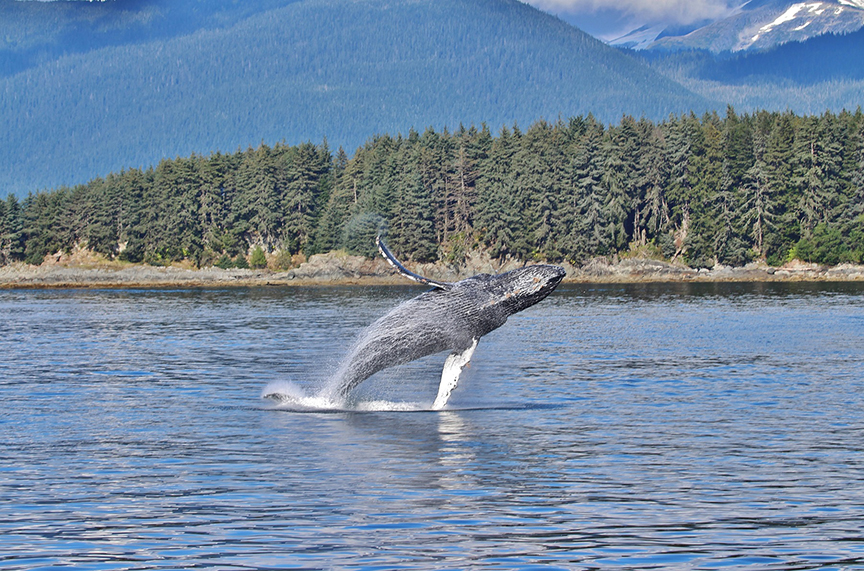A producer pursues her vision of a feminist TV show.
One glance at the promo for her TV show was enough to send her heart plummeting like an elevator with snapped cables. The ad depicted a female flight attendant—or stewardess, as they were once universally called—lying in bed, partially draped in a sheet, wearing only a jaunty Pan Am flight cap. To the show’s originator/executive producer, Nancy Hult Ganis ’78, M.J. ’81, it was the utter antithesis of her vision.
The 2011 pilot for ABC’s series Pan Am had not even aired yet, “and suddenly, before we even got started, I felt I was failing,” said Hult Ganis. “I knew that no matter what, I had to do everything I could to kill that ad. It was a betrayal of the true history of the intelligent, accomplished, adventurous women who flew for Pan Am. It played straight into a ‘coffee, tea, or me?’ stereotype, which was totally false.”
The “Hollywood boys club” was considering the show’s competition to be another new drama, The Playboy Club (2011), and presumed that sex sells. But they were underestimating how personally invested producer Hult Ganis was in this, her first network show. She had been longing to share these stories since her days as a Pan Am stewardess from 1968 to 1976. The now-defunct Pan American World Airways flew only internationally, and its stewardesses—all female and single—were required to be college educated and multilingual. They were responsible for transporting heads of state, the U.S. press corps, and the Beatles. They were trained to handle life on the edge—from mechanical failures to military coups—and were issued cards identifying them as commissioned Air Force second lieutenants, to give them Geneva Conventions protections. “This was a job that empowered young women in that era. We didn’t sleep our way around the world,” said Hult Ganis. “It was just so disheartening to me what they distilled it down to.”
She got the offending promo pulled before mass distribution. Nevertheless, the dispute diminished her influence on the show, she said—despite her producing credentials, which include the award-wining film Akeelah and the Bee, and despite the fact that her husband and business partner is Sid Ganis, former head of Paramount Pictures and ex-president of The Academy of Motion Picture Arts and Sciences.
“My stomach was in knots before the pilot even aired, because I saw what was happening,” she recalls, “and I realized the point in retrospect where I gave my power away.”
As the show continued, Pan Am plots emphasized sexual entanglements while shortchanging political and cultural context. A New York Times review noted that “the show does try to broaden the story with a few Cold War subplots: A Pan Am flight crew is assigned to help retrieve survivors of the Bay of Pigs disaster in Castro’s Cuba; British counterintelligence agents use airline employees to spy and pass secrets. Mostly, though, the espionage feels like padding, a way to assure viewers that they are not just watching early prototypes of Carrie Bradshaw and her posse—Sex and the Cockpit.”
Ratings nose-dived. Last year, ABC cancelled Pan Am after just one season.
“Nancy is more and more of a rare bird in this world that we work in, where it is hard to find people with such a social conscience,” said production designer Bob Shaw. As the man who gave the Mad Men pilot and Boardwalk Empire their distinctive visuals, Shaw originally intended to design the Kodachrome sheen of just the pilot Pan Am episode. He stayed on in part because he was impressed with Hult Ganis—”such a very cultured and rather refined lady … the kind you don’t meet much anymore”—and her commitment to a more intellectual, authentic capturing of untold history.
“I really wanted to help Nancy’s vision find its audience, and it was a battle, and I think we lost a lot of the battle,” he said. “I think she believed in her concept so strongly that she didn’t understand how anyone could possibly not share her belief.”
A year later, Hult Ganis describes herself as wiser, saying the Pan Am experience taught her to retain control over scripting, get everything in writing, and pursue other venues for content, including online and overseas distributors. She’s now prepping to launch a TV series on women of the Resistance and a film about Black Panther Johnny Spain. She also wants to produce a biopic on Bessie Coleman, the first African-American female pilot.
Those who know her best trace her instincts for material back to her years collecting stories as a stewardess, reporting stories as a journalist, and studying both history and journalism at Berkeley.
“In Los Angeles, she always seemed kind of like a fish out of water,” said her friend, film producer Ruth Charny. “The ethos and spirit of Berkeley were so quintessential to Nancy that you could move her to Southern California and, no matter how deep the hole you dug for her, she was still going to retain her Northern Californian values…. It’s not as if she didn’t flourish there. She understands the value of entertainment as a teaching tool. But she incorporates into entertainment her sense of right and wrong, and the fact that it’s a big world out there and people should know about it.”
That recognition is reciprocal, and it explains her value as an advisory board member to Berkeley’s Goldman School of Public Policy for the past eight years. “Increasingly, we realize that formulating good policy isn’t enough,” said Dean Henry Brady. “You might formulate a policy and think that any sensible person would see that approach is the best one, but the truth is you’ve got to get it out there and persuade the public, and that means understanding how journalism and entertainment shape people’s views about policy. Nancy is in an excellent position to give us that.”
It all comes down to storytelling with integrity. “The journalist in me had to discover,” she said, “that it’s sometimes easier to tell the truth through fiction.”
These days, Nancy Hult Ganis can be found in remote Bolinas at her expansive cottage on a bluff, which lacks high-speed Internet and cable TV but offers a spectacular view of Mount Tamalpais and Stinson Beach. There is not a remnant of Hollywood in sight, unless one counts the vultures that ominously perch in the backyard.
She spent a recent summer day, with a sheer curtain of mist enveloping the coast, toggling between phone calls that were professional—Is it time to approach actor Laurence Fishburne about signing on to the Johnny Spain film? What’s the status of the first treatment for the Heroic Women series on the Resistance?—and personal—How is her mother’s health? Will her daughter bust her for treating the grandson to an ice cream cone?
Today, Hult Ganis is elegantly dressed in leggings and a black shirt topped with a long, cream-colored cashmere vest. The living room and kitchen run together along a line of windows looking out past the porch swing, garden, and deck, to the beach below. Inside, the furnishings are French country pine; a grand piano occupies a corner beyond the fireplace. She fills a bowl with nuts to munch and settles into a windowside booth, pushing aside a Gettysburg jigsaw puzzle and wooden Scrabble set. (“I’ll tell you something about my wife,” Sid Ganis would later confide. “Never play dominoes with her. Scrabble either. She is fiercely competitive.”) As comfortable as Nancy looks here, she acknowledges a restless spirit assuaged only by travel—she has just returned from Washington, D.C., where she visited the CIA to research her project on women of the Resistance.
“My mother said I came out of the womb ready to go, and learning to ride a tricycle was just my first means out of town,” she said of her origins in suburban Detroit. She was on the verge of graduating from the University of Michigan and becoming a math teacher when she was stopped in her tracks by a Pan Am recruiting poster: “Our stewardesses know their way around the world better than most people know their way around the block.” The job interview drew a throng—the applicant next to her held a master’s in Russian literature and spoke five languages—but Hult Ganis was selected and dispatched to Miami for training.
It may be difficult now to envision stewardesses as pioneer feminists, but they were seizing the best career opportunity available to see the world. Patricia Ireland, prior to becoming president of the National Organization for Women, was a Pan Am stewardess. Yes, they were subjected to grooming standards, had weekly weigh-ins, and were checked to be sure they were clad in girdles. But Hult Ganis points out that the pilots also had rigorous personal requirements. Pan Am embraced a military model: spit and polish, one and all. In those days, travel was a celebrated event for which passengers dressed up.
“Nancy, while never impolite, spoke her mind [and] wasn’t afraid to push the envelope,” recalls Hult Ganis’s roommate Sandy Javaras. She was concerned about civil rights and political activism … and she could wear a bikini. She was the most self-actualized woman I had ever met.”
For the next eight years, Hult Ganis lived the robust life of a globe-trotter, gathering sensational material that would later inform her careers in journalism and entertainment. She reminisces about how she flew into Vietnam during the war and was in seven revolutions—once stranded in the air following a 14-hour flight because of a coup. She recalls how she learned Farsi in Iran, trekked the Khyber Pass in Afghanistan, caught a train across Kenya and watched giraffes graze under the full moon, and visited the village of a Maasai warrior who presented her with a sword and shield. She says that later, she and her friends ended up short on cash, and a hotel clerk confiscated the sword and shield as room payment.
Hult Ganis credits foreign correspondents for helping her shed her American myopia and opening her eyes, for example, to U.S. involvement in overthrowing democratically elected governments in Latin America. One contemporary friend, half-jokingly, professed to wondering whether Nancy Hult Ganis herself had been a CIA agent. She responds with a no: “I was close to it, knew people, but I found that to secretly gain information about people and use it against them—while it may be necessary—gives one a form of power that can compromise one’s integrity. It is done everywhere—by political parties, by secret services, by news organizations, by Internet giants, by corporations trying to sell us something. I think it is a kind of voyeurism and theft combined, and I think we need to be wary of where that can lead.”
It was still a sexist world then, to be sure, and Hult Ganis knew to dilute the drinks of passengers who became inappropriate. She once fended off a man who tried to force himself on her in the galley, by sticking him with a carving fork and declaring, “I’m not included in the price of your ticket”—a scene that would eventually be reenacted by actress Christina Ricci in a Pan Am episode. Pan Am flight attendants took pride in their professional image, which suffered in the 1970s when advertisers began touting stewardesses’ “fly me” sex appeal. Hult Ganis recalled the fateful day at LAX when she first encountered PSA stewardesses uniformed in hot pants, and declared to her fellow crew members, “We’re in trouble now.”
In 1976, she left Pan Am to earn a bachelor’s degree in history at Berkeley, drawn by the University’s challenge to U.S. orthodoxy. When she was preparing her application to the Graduate School of Journalism, a professor offered some ironic advice to the woman whose career had enabled her to experience more of the world than perhaps any other applicant: For God’s sake, don’t let them know you were a stewardess.
In J-School, Hult Ganis envisioned being a foreign correspondent, but her work on a teen pregnancy documentary landed her at San Francisco’s respected public TV station, KQED. When cuts eliminated her position, she took a job promoting the station’s documentaries.
“She was by far the best publicist I ever worked with. Ever,” said documentarian Stephen Talbot, who worked with Hult Ganis on his Peabody-winning The Case of Dashiell Hammett. He recalled her tireless enthusiasm and innovation on a shoestring budget, including staging a themed costume premiere party at John’s Grill, a San Francisco setting in Hammett’s The Maltese Falcon. While collaborating, Talbot revealed to her a detail that he was then trying to keep hush-hush: He had played Gilbert in TV’s Leave It to Beaver. Well, here’s a secret you can hold over me, she confided back: I was a stewardess for Pan Am.
Her promotions work led her to Lucasfilm in San Rafael, to coordinate with the producer of the KQED-destined documentary The Making of ‘Raiders of the Lost Ark.’ The documentary would go on to win an Emmy, and the producer was Sidney Ganis.
“I walked into my office and laid eyes on her, and just like in the cartoons I went ‘bling!'” he recalled. “She was so gorgeous that my instant impression was that she made my heart leap. And then ten minutes into our conversation, she nailed it by simply being herself: smart, excited, asking too many questions because she had such curiosity about everything.” They waited a year before sharing a first date, and romanced for years while pursuing separate careers and handling the demands of parenthood from previous marriages.
Then Hult Ganis moved to Los Angeles for a stint as personal assistant to Steven Spielberg—a crash course in high-stakes filmmaking. “Steven was a joy to watch in action as he exhibited his talents as a director, but the people around him in those days were not my tribe, and I did not fit in.” Everyone was on edge in the aftermath of a 1982 accident on the set of Twilight Zone: The Movie, when a helicopter crash killed three actors. After six weeks, she told Spielberg she wanted to go home.
Back in Berkeley, she worked on media and public relations for producer Saul Zaentz’s film Amadeus and director Francis Ford Coppola’s Peggy Sue Got Married, among others. She also helped found an East Bay school for her daughters. But four years later, when Sid was offered a job as head of worldwide marketing and distribution for Paramount and asked her to follow him to Los Angeles, she balked.
“I don’t do things on spec,” she said.
“Well, then,” he countered, “marry me.”
Instead, she accompanied her friend Pamela Drake on a trip to South America. Hult Ganis also was weighing an attractive job offer from Esprit. “I had to hike Machu Picchu to think things over,” she explained.
“Nancy is no Hollywood trophy wife,” said Drake. “Hollywood is not a comfort place for her. She’s too smart for that. She wants more important and meaningful things. It was a hard decision for her.”
But ultimately, she flew from South America to New York City, rendezvousing with Sid to attend the premiere of Paramount’s Top Gun and, more significantly, to accept his proposal. They married in 1986, blending a family of four daughters and settling in Los Angeles. While Sid got promoted to the pinnacle of Paramount and then advanced at Columbia Pictures, Nancy headed marketing for Carolco Pictures and executive-produced PBS programs such as Straight Talk on Menopause. She found her “tribe”—a group of politically active women who hiked every Sunday. And as Sid began bringing home scripts and consulting her—they both loved the draft of Ghost, for example, and spent a weekend discussing its merits—he became cognizant of her own producing instincts.
“I was caught up in ‘I’m a big-studio dude and I want to stay a big-studio dude,'” he remembers. “But Nancy had been coaxing me on the idea of doing projects together. And one day I realized that I could miss out on the lifetime opportunity of working with her.” So in 1996, they formed their own production company, Out of the Blue…Entertainment.
The company’s biggest financial successes have been goofy, critically panned films such as Big Daddy with Adam Sandler and Deuce Bigalow: Male Gigolo. Those were not Nancy’s projects, and she will simply say that they have an appreciative audience, but “they’re not for me.” If those movies seem to undercut Nancy Ganis’s high ideals, the film on which she worked most closely is a more respectable representation.
Released in 2006, Akeelah and the Bee relays the struggles of an African-American girl from South Los Angeles trying to make the National Spelling Bee. Star performers Laurence Fishburne and Angela Bassett support the debut of 11-year-old actress Keke Palmer. Although a few critics dismissed it as a predictable Rocky for middle school nerds, most found it an inspiring look at the cultural and personal barriers that keep children from being who they can be. It took six years for the film to get a green light, but Nancy, who read the script, had told Sid, “We have to do this movie. It’s about everything I care about.”
“A lot of producers get credits and never visit the set. Nancy was on set every single day,” said fellow producer Danny Llewelyn. “She was always one to see things on the macro-level, beyond just entertainment.”
The cast and crew of Pan Am vouched for her micro-level attention, as well. If the decorator had to be away from the set, everyone knew to “ask Nancy” about details—such as the portion sizes of airplane meals back in the day when stewardesses carved prime rib and flambéed cherries jubilee right in the aisles. (Her penchant for accuracy was not shared by those in control of the show. Example: One of them complained about the Bay of Pigs episode, grousing, “What’s this Cuban thing doing in here? This isn’t a history lesson!”)
But Nancy Hult Ganis had fallen in love with history lessons at Berkeley, brought to life by professors such as Leon Litwack and Paula Fass. “Oh my God,” she said, “I wish I could have stayed there forever, because every day they opened up the world to me.” She remains a proponent of history—full of intrigue and suspense and grandeur, deepening our insight while entertaining us in the process. She is particularly fascinated by women’s history, perhaps precisely because so much of it has yet to be told.
Ever hear about the woman who talked a young Adolph Hitler out of suicide? Or about the Night Witches, female pilots who flew for Stalin after the Nazis decimated the Soviet air force? Or about Virginia Hall, the Baltimore-bred spy working in France who fled to Spain to evade the Gestapo, climbing over the snowy Pyrenees mountains—on her wooden leg? If not, you are the target audience for a future Nancy Hult Ganis production.
“You can call straightforward idealism like hers naïveté or stupidity or anything negative you choose,” Sid said, “or you can call it admirable and passionate and noble.”
And does he believe that her brand of idealism—say, for example, her vision of Pan Am—can also be commercially successful? “Hell, yeah,” he shot back. “Absolutely.”
The proof may not be far off, if she can line up financing and partners outside of traditional Hollywood. Besides, she said with a chuckle, “my husband and I have been in the business long enough that those who were our nemeses, or the biggest obstacles to doing what we want, are either dead or indicted. I’m not kidding.”
Eventually she would like to resurrect Pan Am, with a new title and cast if need be, and do it right. “And why not?” she asked. “They’ve done a million war stories, a million cop shows, a million hospital shows. We haven’t even scratched the surface of the stories we could tell.”
Including, perhaps, her own. She noted that her chum, the entrepreneur and Democratic donor extraordinaire Susie Tompkins Buell, has told her that the story within the story—the real life of Nancy Hult Ganis—is the one she needs to write.
“It has been an interesting life,” Nancy acknowledged with a brilliant smile. “And there’s a lot you don’t know about.”



















